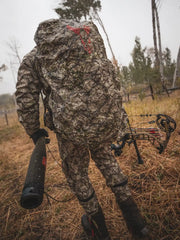Hot and cold. Sweet and salty. Betty and Veronica.
Life is all about balance. Nature works very hard to maintain an equilibrium, and when something gets out of whack, there can be extreme shifts to get back to the center. Earthquakes, volcanic eruptions and eating Wing Hutz' “Thermo-Hyper Hot Colon-Cleansing Wings” are just a few examples.
Finding the sweet spot between two opposing elements is generally the key to happiness. Another key to happiness? Big ol’ bucks in the fall.
Care to guess the trick to keeping the whitetail on your hunting spread and out of the neighbors’? Yup, balance.
Our pal Jerry “J-Rod” Tibbott of The Bearded Buck recently gave us the lowdown on how he and his crew provide a balanced food plot to keep the whitetail interested, healthy and growing. What does Jerry know about food plots and whitetail habitat? Well, he was named the 2018 Deer Manager of the Year by the Quality Deer Management Association.
Balance for a food plot involves the right mix of perennial and annual plants. For those unfamiliar, like us, perennial plants are those that are planted once, then return for several years. Annuals need to be replanted every year.
J-Rod has found that a 65%/35% blend of perennial to annual plants works best for The Bearded Buck farm. This creates a quick growing field of tasty nutrition during the hot summer months, which then evolves into a hardier crop that lasts into the cold fall and winter months. Constant nutrition, in a reliable place is key to keeping those big deer near you.
Let’s start with the summer perennial plantings. These are some food plot favorites such as clover, chicory and alfalfa. Fast-growing, this mix provides the nutrition needed during the summertime, when it can be more challenging to put on weight in the heat. It’s critical to provide the needed nutrients during this season, as that’s when antler development is in full swing. Delaying growth now, means smaller deer and smaller racks come hunting season.
For the annuals, there’s a wide variety depending on where you live. J-Rod and the boys prefer a mix of the cereal grains (wheat, rye, oats), along with arrowleaf, grape, turnips, kale and sugar beets.
These hardier crops take a little longer to develop, but will last well into the first snowfall and provide the nutrition needed to keep your deer healthy and strong.
In some regions, corn and soybeans are also used as food plot fodder, but the poor guys at The Bearded Buck farm have too large a deer population. (So sad). For them to provide enough corn or soybeans would require a far larger food plot than they have.
When in doubt, consult your local game and wildlife department. The biologists there can help you figure out what the appropriate crop is for your food plot, as well as when to plant and where. They can also help you avoid trouble later on by accidentally putting down an invasive or dominant plant.
In the end, deer are just like you and us. They want tasty treats, relatively close to the couch, and they want them year round. Treat your resident whitetails like guests at a Super Bowl party and feed ‘em well.















